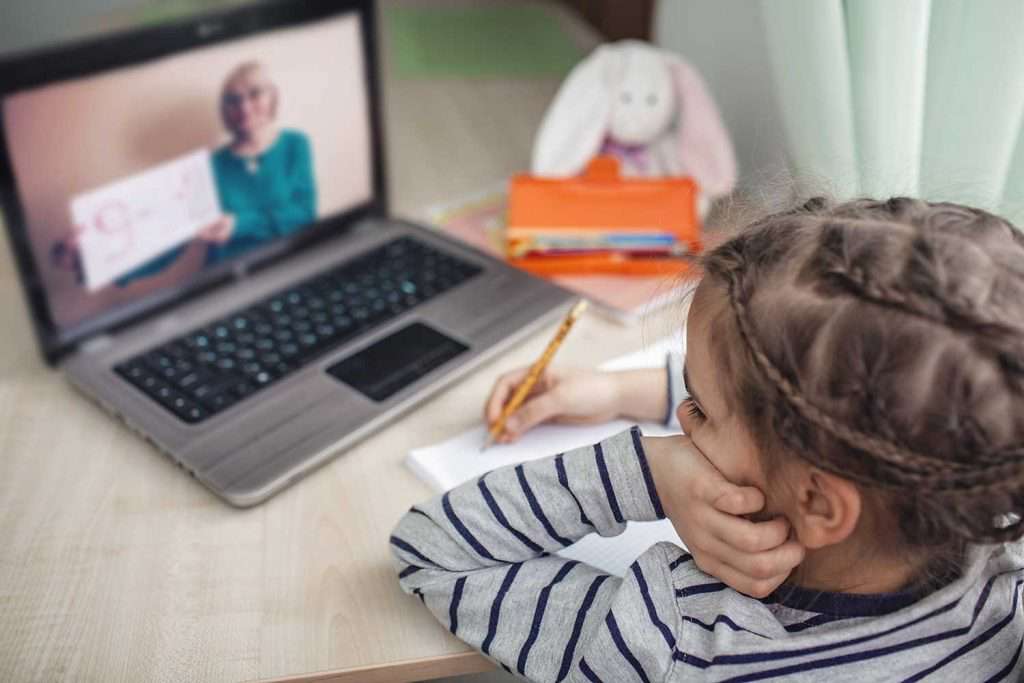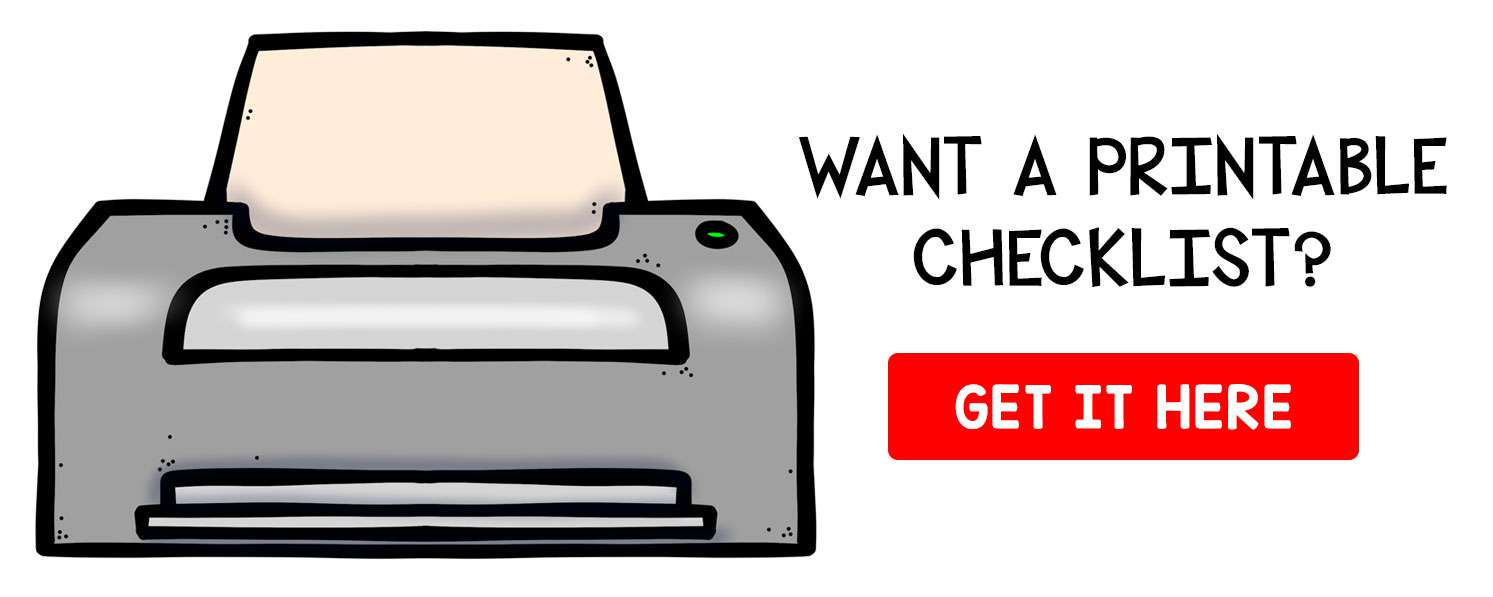If you’re considering homeschooling or just starting to homeschool then you might be asking yourself how to homeschool for free, or at least find some cheap homeschool ideas to stay on a frugal budget. So today I’d like to share some tips with you that will help you to find free homeschool resources and ideas that will help you to do that.

Free Homeschool: Is It Possible?
Homeschooling can get expensive if you let it. And, hey, if you have the budget to buy the latest homeschool gadgets or to stock up your Montessori homeschool classroom to the brim then by all means, go for it. There will never be a shortage of wonderful teaching tools, great books, and homeschool curriculum that you can add to your homeschool classroom. And all of that can be really fun and great teaching aids. However, that doesn’t mean they are necessary to be able to homeschool.
There are so many great free homeschool resources out there and if you don’t have an endless budget then you’ll need to learn how to homeschool for free or cheap at least for the most part.
So let’s talk about some tips and ways that you can homeschool for free (or mostly free). Of course there might be some supplies here and there that you’ll need to invest in, but if you think frugally then you can keep that list to a minimum.
Lay the Groundwork
As you begin browsing through free homeschool curriculum and printables you’ll need to first know what you’re looking for. Otherwise you’ll be spinning your wheels and following every rabbit hole that you find (and there are a lot of potential rabbit holes when it comes to planning your homeschool).

So before you begin searching out free homeschool resources set the stage and determine and make note of things like:
- The legal requirements in your state
- Your child’s current grade level
- Your preferred homeschooling method (at the moment)
- Your teaching style
- How your child learns best
- What subjects you want to cover (above and beyond the legal requirements)
- Your interests and your child’s interests
I talk about a lot of this laying the groundwork in my post on how to start homeschooling so be sure to hop over there and read through that for some ideas on how to lay the groundwork for your homeschool. It’s essential stuff that you’ll need to know as you move towards your goal of homeschooling for free.
Take Stock of What You Have
You probably already have access to a lot of great things that can be used for homeschooling, and you don’t even realize it! Start to take stock of what you have.

Free Homeschool Supplies Around the House
Look through your office supplies for pencils, paper, etc. that can be used for homeschooling. Browse through your bookshelves or stacks of books. Take a look at your children’s toys, puzzles, and board games and see what you might be able to utilize for educational purposes in your homeschooling.
As you go through your home, take a piece of paper and a pencil and make note of all the things that you think you could use for your homeschool. You can even write down any great learning ideas that spark as you are looking around.
Save Those Containers for Homeschool!
Another place you might not have already been looking for free homeschool supplies is in your kitchen! If you haven’t already, consider washing out and saving various containers and things that you would normally put in the recycling bin. There are often a lot of great uses for these types of things like in sensory bins, crafts, and science projects.
Media You Already Have Access To
Also be sure to consider looking for learning material in places you might already have subscriptions to. For example there are a lot of great educational movies and shows to be found on Amazon Prime, Netflix, and your local cable channels. If you already have a subscriptions to these, then browse through them and save anything that looks promising to your watch list for later.
Plus, if you have Amazon Prime then you can also consider all of the other things included in your subscription like free Kindle books and free music that you can utilize in your homeschool for free. Yes, these services cost money, however if you already have them then I would consider it a free bonus to be able to use them in your homeschool too.
Consider What You Can Borrow
If you’re trying to homeschool for free then another thing you can consider if you’re comfortable with it is seeing what you can borrow from friends, family members, and other homeschooling families.

Don’t become obnoxious about asking to borrow supplies and curriculum from them on a frequent basis. However, you can share with them that you are considering homeschooling but you’re on a tight budget. And if they seem open to it, ask them if they would mind if you borrowed a curriculum they’re not using or certain homeschool supplies they might not have a use for at the moment.
Again, I can’t stress enough that you don’t want to ask to borrow every single element for your homeschooling. So keep it to the really big stuff that you don’t want to have to splurge on. And if they do agree to let you borrow something, be sure to treat what they share with the utmost respect by taking good care of it and returning it in a timely manner.
Give (and Ask for) The Gift of Homeschooling
While it might seem boring to some, homeschool supplies can actually be incredibly fun. There are a lot of great educational toys that can be used in your homeschool and there are educational supplies that can seem like toys to your children because they’re so much fun.

So when it comes to gift-giving time consider making it an opportunity to stock up on some fun homeschool supplies that your children will love. Give them gifts for their birthday and other holidays that you know you can utilize in your homeschooling. And if you have friends and family who give your children gifts too go ahead and ask for specific or generic educational gifts that you know will benefit your homeschool days.
You might think that your kids will call you out on this, but if you instill in them a love for learning then you might be surprised when they actually love these kinds of gifts.
Familiarize Yourself With Your Library
There are a lot of great free services out there, but as a homeschooler probably the most valuable of them all is your local library. Not only can you stock up on the books you need for your homeschool for free, but you can even check out educational movies, documentaries, and audiobooks too.

As you familiarize yourself with your library also check to see if they are part of a library network. If they are, then you might have access to even more books than those that are on your local library’s shelves. Our library allows us to place books on hold from a network of libraries all throughout our state and once they come in, we can pick them up from our local library.
Plus, there are other services your library probably offers that you might not have even considered using for homeschool. Typically the library offers the use of their computers and Wifi for free so if you don’t have access to a computer or the internet at home, you can take special trips to the library to get anything you or your children need to do on the internet done.
Your library might even offer the use of their printer. In this case, they might charge a small fee, but even so you might find this more affordable for your family than buying a printer for your home.
Another awesome thing that most libraries offer are free classes for various ages and topics. Keep your finger on the pulse of what’s going on at the library so you can jump on any free opportunities that you think would fit nicely into your homeschooling.
Find Free Homeschool Curriculum
There are a lot of great free homeschool curriculum options out there for all sorts of different homeschool methods, styles, and grade levels. While there is a lot of curriculum that costs money, you can certainly find curriculum for your child that is free as well.

Here are a just a few of the more popular free homeschool curriculum choices:
For more ideas, you can check out this list of free homeschool curriculum and resources that I wrote on my other blog. There is also a great collection of links to free curriculum at An Old-Fashioned Education and Freedom Homeschooling.
Write Reviews in Exchange for Homeschool Curriculum & Resources
Another route you can try taking when it comes to your homeschool is to write reviews and testimonials for various homeschool curriculum and resources in exchange for those items. You don’t necessarily have to have a blog to do this, but that does certainly help lend to your credibility. But if you don’t want to start a blog, you can always offer to write reviews on Amazon for products, Goodreads for books, and even offer for them to use your testimonial on their website.

If you’re not a fan of any of the free homeschool curriculum out there or you have your heart set on something specific then why not trying to get in touch with the publisher of the homeschool curriculum you’d like to try. Share with them a little bit about you, your family, and your homeschool journey or plans so far. Tell them about how you’re interested in their curriculum and that would like to offer an honest review or testimonial in exchange for a copy of the curriculum.
You can also try to do this for other various homeschool supplies and resources that you have your eye on too. You’ll have to do a little hunting to find the right contact information and it’s definitely not guaranteed, but you might find it worth it to try.
Here are some various homeschool resources that you could try writing honest reviews for in exchange for what you need:
- Books
- Curriculum
- Educational Supplies
- Educational Games
- Educational Apps
- Educational Videos and Documentaries
- Educational Toys
- etc. (anything you need for your homeschool)
Teach Using Unit Studies Instead of a Boxed Curriculum
One of my personal favorite ways to do homeschool with my kids is through unit studies. Unit studies are basically when you pick a central subject that you can study more in depth over a period of time (usually between 1-4 weeks but however long you want). Within this unit study you incorporate all (or most) of the subjects your children need to learn.

As you plan out a unit study you would select related books, crafts, and activities that will help your child to learn about that theme while also practicing vital skills from other subjects such as math and literacy.
So as an example you might decide to do a unit study on ants. You would pick up a bunch of books about ants from the library, select some crafts that might be fun as your children learn about ants, and plan out some fun ant themed activities that would incorporate other key subjects like math, reading, and literacy for your children to do.
Like with anything else in homeschooling, unit studies could end up costing you a fortune if you let it. However, you can also do these kinds of studies for free or practically free by getting your unit study books from the library and finding free craft ideas, activities, and printables from Pinterest and other online sources.
Even though unit studies might take more planning, they can open up so many doors to learning for your children and they could help you to homeschool for free if you plan them accordingly.
Utilize Free Homeschool Printables and Online Resources
One of the great things about homeschooling is all of the amazing teaching resources at your fingertips. There are so many great free printables and activity ideas for all ages, grade levels, subjects, and themes. Whatever it is you’re looking for is probably out there for free.

The very first place you’ll probably want to look for free homeschool printables is Pinterest. Yes, you can use Google too, but I personally find it a lot easier to find what I’m looking for using Pinterest because it’s visual. I also have a few favorite websites that I like to find free homeschool printables from as well, like:
- Teachers Pay Teachers (you can narrow it down to only free stuff)
- Tot Schooling
- 123 Homeschool 4 Me
- The Measured Mom
- Free Homeschool Deals
These are just a few of my favorites, but again Pinterest is your best friend as you plan out your homeschool for free!
Use Free Educational Games, Apps, and Websites in Your Homeschool
Although you certainly don’t want to stick your child in front of their iPad all day and call it school, there are a lot of excellent free educational games, apps, and websites to be found through phone and tablet apps and online that can be used to supplement your homeschool for free.

As you search for free games, apps, and websites that you can use in your homeschool be sure to consider the math, literacy, and other essential skills that your child needs to learn for their age/grade.
Be sure to go through any websites, apps, and games that you want to use before letting your child try them. Make sure that there aren’t any inappropriate ads that they could click through and you’ll also want to verify that your child can’t upgrade without your consent. Most children’s apps, games, and websites should have safeguards in place to prevent that from happening.
Along those same lines you’ll also want to keep in mind that most free websites, apps, games for children will be limited until you upgrade. If you find that something that your child seems to be thriving on and learning from then consider if it’s worth it for your homeschool to go a head and upgrade. Otherwise you can utilize what you can and find other apps and games to learn any other skills that they might need to practice.
Here are a few free educational games and apps for children that you could try. There are so many more great ones out there but these are just a few good ones:
- PBS Kids Games (website and app for iPhone and iPad)
- Khan Academy Kids (website and app for iPhone and iPad)
- ABC Kids Tracing & Phonics (for iPhone and iPad)
Again, there are much more free educational games, apps, and websites out there. I will be rounding up a larger list of these down the road and when I do I will link to it here.
Make Free Educational Videos Part of Your Homeschool
Did you know that you have access to a plethora of educational videos. From videos to learn the alphabet to science videos, to cooking and hobby classes, and even videos teaching children how to use instruments. With the internet, there is an endless supply of free information at your fingertips.

One of the best places online that you can find free educational videos is YouTube, believe it or not. You can find things like documentaries, how to videos, basic preschool skills videos, science videos, history videos, cooking classes, other hobby classes, and even music lessons. Just be sure to monitor your child’s activity on YouTube carefully because it can be easy to get off topic. Turn Auto Play off and stay close as they watch their homeschool videos, or watch them with them!
Other Places to Find Free Educational Videos
While YouTube is my favorite place to find free educational videos to supplement in our homeschool, it isn’t the only place that you can use to help you homeschool for free. Here are some other great places to find free educational videos.
- Watch Know Learn – A directory of children’s educational videos organized by age and subject.
- Khan Academy – Tons of free video courses and classes for all age ranges and subjects.
- HowCast – How to videos on a wide range of topics (not specifically geared towards children so use caution)
Subscription Services With Educational Videos
Also if you have subscriptions to any of these then there are lots of great documentaries and educational videos to be found at no additional cost:
Devices to Find Free Videos for Homeschooling
Additionally if you have a Roku, Amazon Fire Stick, or another streaming device then often times you can find channels or apps that offer even more free video content that can be used to help you homeschool for free.
And don’t forget that you can even find educational video apps on your phone or tablet, even if you don’t have a specific streaming device like a Roku or Amazon Fire Stick.
Don’t Forget Your Library for Free Educational Videos
And finally don’t overlook your library for free homeschool videos. You can usually find a lot of great choices for videos and documentaries at the library, especially if they are participating in a library network.
Scope Out Free Local Classes and Services
While your library is definitely the top free local service you’ll utilize in order to homeschool for free, there are a lot of other great local services and classes that you can find for free too.

Sometimes there are ongoing type services like free classes at the craft store while other times there might be special free opportunities that you’ll want to jump on as you find them. Here are a few ideas for places to look for free local classes and services that you can look into and potentially use in your homeschool:
- Classes at your local library
- Local nature centers
- Free days at local museums
- Free days at local zoos and aquariums
- Craft classes at the arts & craft store
- Free classes at your community center
- Free extracurricular classes at your local school (band, PE, etc.)
- Local businesses that offer tours and classes about their services
- Free factory tours
- Free classes and extracurricular activities through your church
- Classes and workshops at Home Depot or Lowes
These are just a few ideas for finding free local classes and services that you can incorporate into your free homeschool model. Be sure to always be on the lookout for free offerings in your own area. You can also check out The Homeschool Mom’s list of other local co-ops and services here. She has a great comprehensive list of local things organized by state.
Take Advantage of Free Books, eBooks, and Audiobooks
Books are going to be a big part of your homeschooling. Whether you make learning from books your primary source of learning material or whether you plan to just use books alongside another boxed curriculum or homeschooling method, you will need books. Lots and lots of books. And this can get pricey pretty quick if you’re building your own homeschool library, even if you buy all used books. And while building your own homeschool library can be a wonderful thing, it isn’t always feasible.

But thankfully there are a lot of great ways that you can find books for free. Here are just a few ideas for places to find free books:
- Local Library – The BEST place to find what you’re looking for.
- Local Library Network / Partner Libraries – Libraries in your area connected by a network. You can ask your local library about this.
- OverDrive – Find eBooks and Audiobooks to check out from the library (must have library card)
- Ask your library if they ever have times when they give away books that are being taken out of circulation
- Free Kindle Books (if you’re an Amazon Prime member)
- Project Gutenberg (free public domain eBooks)
- PJ Library Free Book of the Month
- Dolly Parton’s Imagination Library
- Find a Little Free Library box near you (take a book, leave a book)
- FreeKidsBooks.org
- Search for a book bank in your area (a book bank is a place where people can donate books and others can pick up free books)
- Swap books for just the price of postage with book exchange sites like BookMooch and Paperback Swap
- Contact authors and publishing companies to offer an honest review on Amazon or your blog (if you have one) in exchange for a copy of a book you’re looking for
- Loyal Books (Books Should Be Free) (free public domain eBooks)
- Oxford Owl Free eBooks for Children
- Free Children’s Stories for original children’s books read along videos
- Storyberries for classic and original children’s stories
- University of Pennsylvania Online Books Archive (difficult to navigate but has a search option and might have something you’re looking for)
- Storyline Online – Children’s book read alouds by famous people
These are just a few of the many places you can find free physical books, eBooks, and audiobooks. I plan to write a whole post with even more ideas for where to find free children’s books and when I do I will link to that here.
Organize Free and Cheap Field Trips
As part of your homeschool you might want to also include days for special field trips whether just for fun or for educational purposes. You might even have a dream of doing even more field trips with your child than they would normally have at regular school. But these kinds of field trips can add up quickly for homeschoolers. Is it possible to have free (or at least cheap) field trips for homeschool?

Thankfully there are ways that you can plan free (or mostly free) homeschool field trips. You might have to get creative and keep your eyes open for deals going on, but there are ways that you can find field trip ideas for free.
Here are just a few ideas to try and places to look for free homeschool field trips:
- Explore the outdoors by hiking and going for walks. You can make it even more educational by starting a nature journal or by focusing on something in nature to look out for and observer.
- Go to the park and playgrounds. Lots of parks offer a lot of great walking trails and places to do various sports providing you bring your own equipment. You can also let your kids burn some energy on the playgrounds at the park too.
- Look for free petting zoos in your area. Sometimes you can find free petting zoos in your area. We have one attached to a county park near us that’s really neat and completely free.
- Visit your local pet store. If you don’t have a free petting zoo near you, then you might just have a local pet store that actually has pets (not just supplies). If you do, then this would be a really fun field trip idea. You can make it even more educational by researching and learning more about the animals you see there when you get home.
- Take advantage of church outings for your kids. Youth programs at church will often plan special get-togethers and outings that you can have your kids go on for field trips.
- Join a homeschool co-op or group. If you can find a local homeschool co-op often times they will put together free or cheap field trips to go on as a group in order to socialize and utilize available group discounts.
- Local businesses, factories, and restaurants. Lots of businesses, factories, bakeries, and restaurants will offer free guided tours and workshops about how their business works and the products they serve. These could be great educational opportunities while also fun field trips for your kids.
- Tours of city services. If you call ahead and plan it out, then places like the post office, fire department, police department, etc. often will allow you to tour their facilities and give your kids a bit of education on them in the meantime. You might even be able to set up interviews with your local mayor or other city representative too.
- Go to historical buildings and churches. Make a list of some local historical buildings and call around to see if any of them offer tours or allow people to visit and look around. Be sure to mention that you’re homeschoolers because they might be more willing to set something up if it’s for educational purposes.
These are just a few ideas that you can try for free field trip ideas. Also be sure to keep your nose to the ground for special free days at local museums and zoos that would make good field trips.
Connect With Homeschool Co-Ops, Groups, and Programs
The last free homeschool idea I want to talk about is finding opportunities to connect with other homeschool families either through homeschool co-ops or other homeschool groups and programs. Doing this can open up more doors for learning and help you to find even more ideas on how to homeschool for free.

There are lots of great ways to connect with other homeschooling families either locally or online. And doing so can really help you to feel motivated, connected, find answers to questions you might have, and give you even more free homeschool ideas. There are other families who homeschool that have already walked in your shoes when it comes to just starting to homeschool, and they can offer valuable advice and encouragement.
With homeschooling becoming more prevalent you should be able to find one or more groups of homeschoolers that can help you on your journey. Here are just a few ideas for where to connect:
- Find a local homeschool co-op
- See if your church has a homeschool group to connect with (or put one together if they don’t)
- Look out for homeschool curriculum exchanges near you
- Search for Facebook Groups for homeschoolers
- Get connected to other homeschoolers through blogs and those blogs’ social media pages
- Join online homeschooling forums
Connecting with other homeschooling families will make this journey less daunting, more fun, and help you to find all the free and cheap resources available to you.
Now You Know How to Homeschool for Free
You’re now armed with a lot of great free homeschool resources. You have a better idea of how to homeschool for free. And that’s great! But I’d like to point out that even though it is completely possible to homeschool for free, especially when you’re just getting started, that doesn’t always means it’s the best option for everyone.
Homeschooling for free can sometimes take more work and be more stressful because you need to do a lot more research in order to find what you need. You might just end up paying for it with your time. In some cases you might end up sacrificing quality. And in other cases you might be trying to fit a curriculum or method into your (and your child’s) style when it just isn’t the right fit.
So even though you can certainly work hard to homeschool for free, also remain open to spending some money if needed on key supplies like a good printer and laminator, and perhaps a curriculum that you feel would be a better fit (if the free ones aren’t working for you and your child).
Free homeschooling is certainly possible. There are so many wonderful free homeschool resources out there that you can utilize whether you challenge yourself to do all of your homeschooling for free or are just trying to homeschool on a budget.
I hope these ideas have helped you learn how to homeschool for free. If you have any other ideas or free homeschool resource ideas please share them in the comments below. I’d love to know about them!


